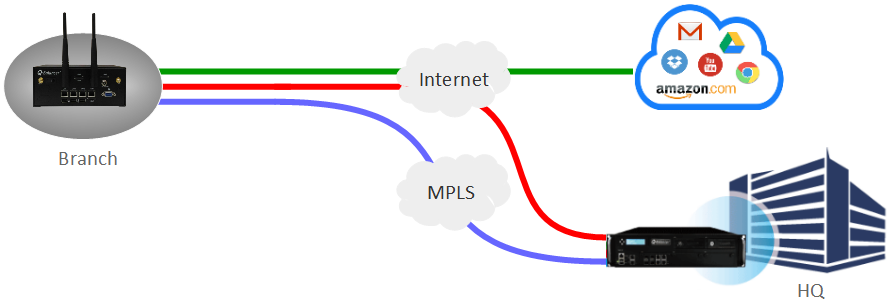Increasing WAN Speed and Reliability through Utilizing Various WAN Transports
MPLS is a widely deployed, reliable and secure technology for building a fixed-path VPN over an IP network between branch and head offices. However, MPLS architecture seems to lack the agility and flexibility, especially for internet surfing or software-as-a-service (SaaS) traffic being backhauled to a central data center or regional hub for Internet access. Besides, adding bandwidth to a MPLS is costly as the service itself is an expensive service, and thus meeting the growing bandwidth requirements with a finite budget is usually hard for IT department.

Traditional WAN
Some legacy WAN architectures have been evolved into multi-WAN networks, which are composed of multiple MPLS transports, or a MPLS paired with an Internet or LTE used in an active/backup fashion. These evolved WAN configurations might already helped leverage both MPLS and broadband circuits at all business locations. However, the organizations with this evolved WAN configurations still face challenges including possible sessions drop on WAN failover, inefficient bandwidth utilization, high bandwidth costs, application downtime, poor SaaS performance, and complex configuration for cloud access.

Hybrid WAN
> WAN Virtualization
WAN Virtualization aggregates various transports of WAN connections into a virtual single connection, and the combination of WAN transports can be multiple MPLS transports, or a MPLS paired with broadband WAN transports. WAN virtualization enables a faster connectivity (the sum of all WAN speed), and is more open, reliable, resilient, agile and cost-effective to enterprise networks than using legacy WAN architectures.

WAN Virtualization
> Performance and Reliability
Cloud traffic can be sent out via the aggregated broadband circuits, delivering maximum possible capacity, while latency-sensitive enterprise application such as VoIP, videoconferencing and VDI can be routed to corporate network via MPLS lines, which usually comes with lowest packet loss and latency.
> Flexible and Scalable
WAN virtualization allows that all WAN connections can be set active based on policy routing whether they are private or public WANs. Enterprise can flexibly employ broadband technologies to expand network capacity, while reserving the private lines for critical applications.
> Greater Bandwidth Utilization
WAN virtualization enables enterprises highly utilize all WAN connections to provide high level of WAN performance and 99.99% WAN reliability, and thus branch offices are able to access central data centers and clouds at a greater speeds.
> Lower Upfront Investment
Money would no longer be wasted on the over-provisioned MPLS bandwidth that is set to cope with the unexpected or uncertain traffic spikes. Plus, enterprises are able to lower upfront investment on their WAN archtectures because bandwidth can thus be incrementally upgraded as the demand grows.
Top Benefits
> Uninterrupted public and private cloud connectivity with WAN resiliency.
> Faster data transmission with efficient WAN utilization.
> High flexibility and scalability to avoid over-provision.
> Optimal business-critical applications delivery.
> Lower CAPEX and OPEX.
























































